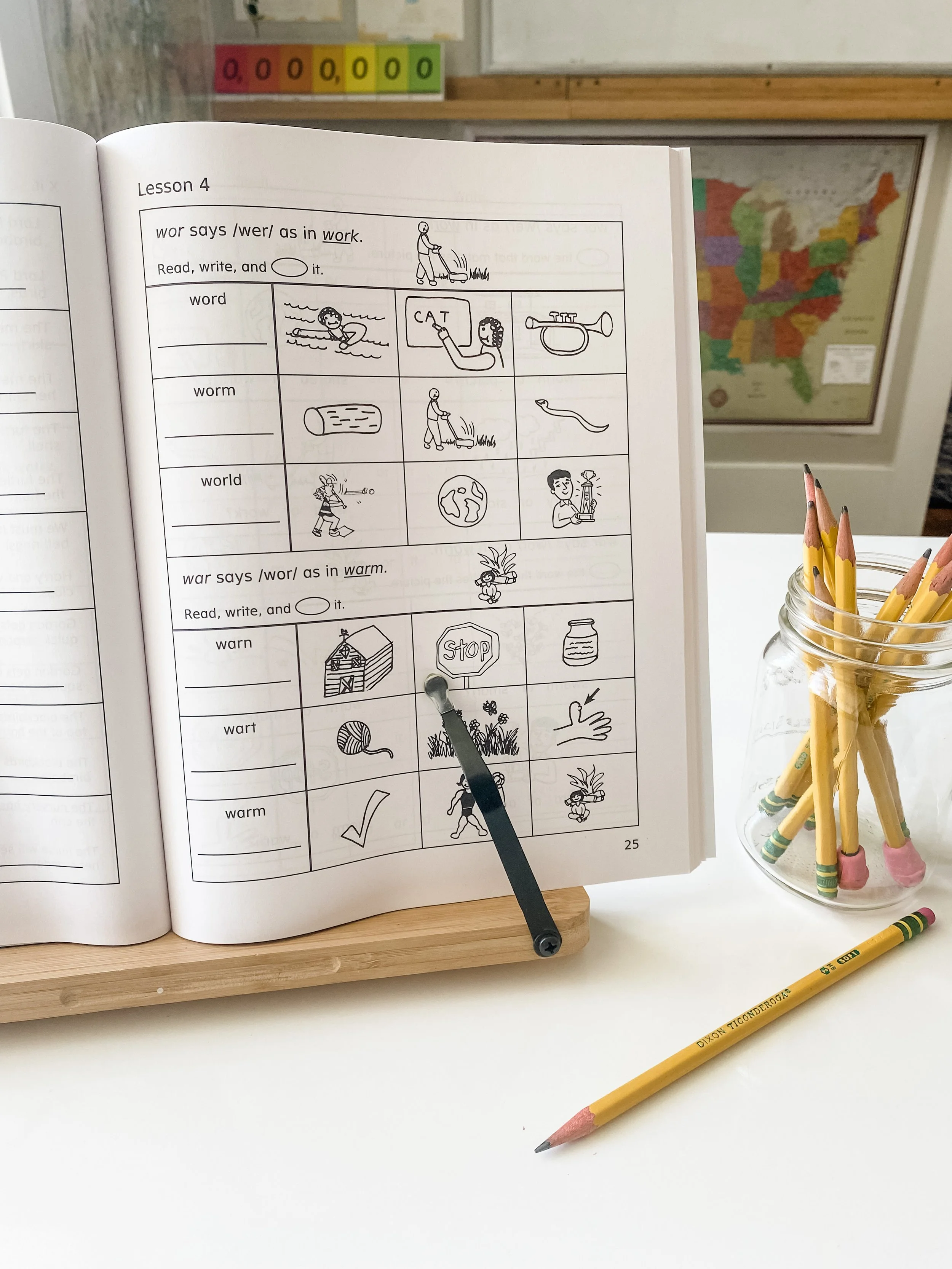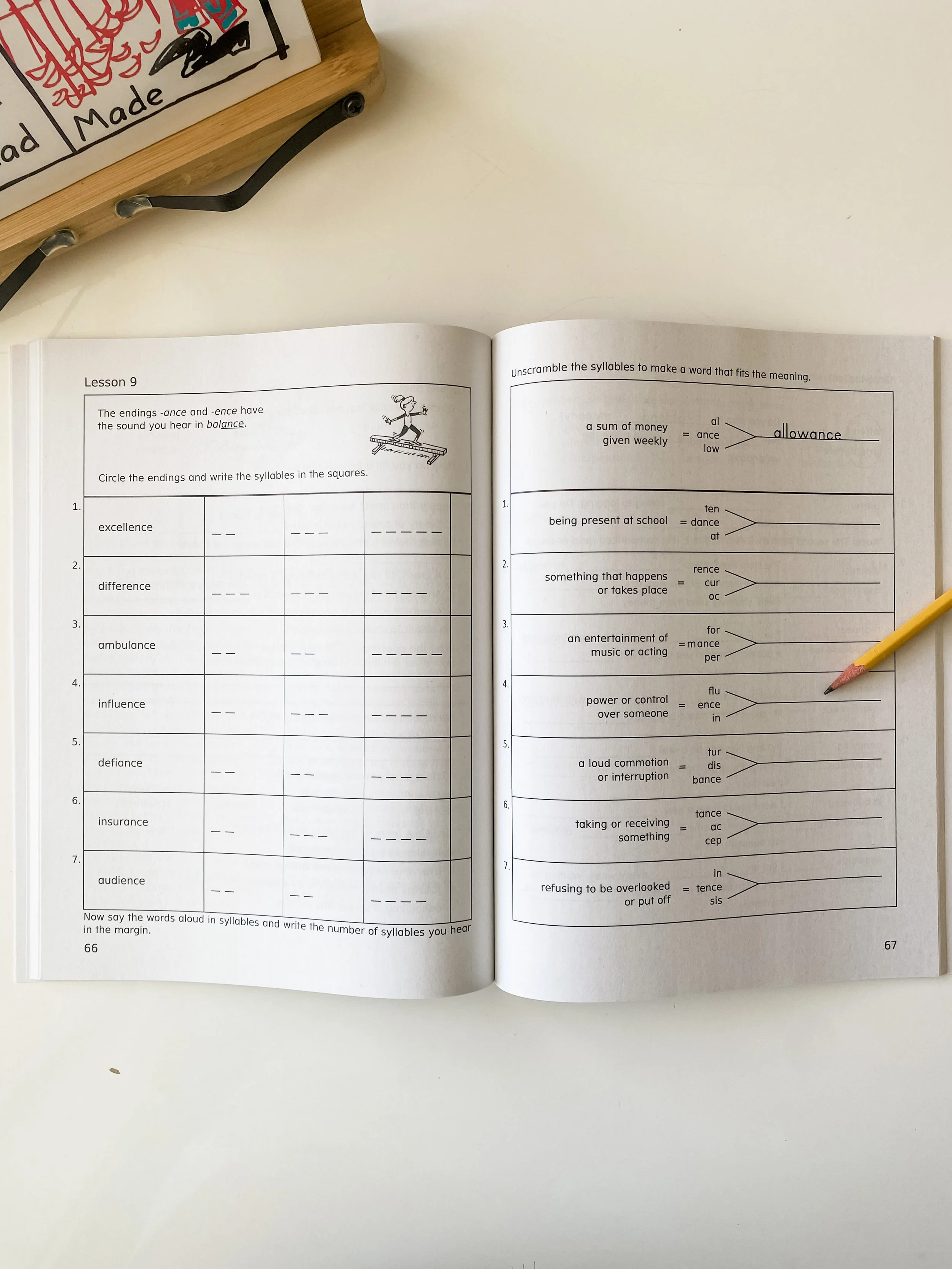Reading & Explode The Code
What is Explode the Code and why all the hype about it? I couldn’t quite figure this out when I saw the books circling around the homeschool world. Last summer I thought we’d try it out with my soon to be kindergartner. He was at the early stages of beginning to read and I knew he would benefit from some extra phonics practice. We decided to keep it simple and work on one page a day. He continued to use it through all of last school year and we’ve loved it so much we’re going to keep on moving through the whole set of books. It has been a fantastic simple supplement to his reading practice and I can see why it’s so popular.
What you should know about ETC:
The Explode the Code workbooks are phonics-based which means they will help your child learn to associate sounds with written letters and words. In the books there is reading practice, a little bit of writing practice, and the content will also help with spelling and vocabulary.
While phonics is a component of Language Arts. ETC is not a full Language Arts program. Some people may choose to use this as their main phonics program, but many people use it as a supplement to a full LA program. We have used it next to The Good and The Beautiful Language Arts.
There are three primer workbooks and eight more workbooks as well as some in-between “half” books. Each workbook is divided up into a handful of lessons that are eight or so pages long. The activity pages are very simple and straight forward. I started in level 1 with my 5 year old son and it worked well for us to do one page a day, but you may find your child can or wants to do more - especially older children. Generally speaking, unless the material is too easy for a child and is serving as a quick review, I tend to err on the side of slow and consistent versus a random firehose of pages all at once.
Additionally there is another 4-set collection called Beyond the Code that can be used for extra comprehension and reasoning practice. Since we have a full LA program, I don’t see us using this set, but some might be interested in it.
There are parent guides that accompany the books, but I haven’t used them and don’t know anyone that has.
There is also an online platform for this material. I’ve also never used this and haven’t see anyone else who has. I don’t know much about it so if you happen to try it out, please share.
You can purchase the books individually or it’s generally cheaper if you can buy them in a set.
Similarly as learning to walk, writing and reading is developmental. This means there are certain brain developments that have to happen before your child reaches certain milestones. Your role is to support them as they move through these different stages. So, it is incredibly helpful to be aware of the stages and phases in reading and writing development. I wrote a recent blog post on emerging readers called Learning to Read Part 1. But, I’d still invite you to do even more research on these milestones.
I point all this out because one thing you might notice about ETC is that the cover pages on books 1-8 show an example of a child’s developmental drawing level while at that stage. So level 1’s cover was probably illustrated by a 6 or 7 year old. As you level up through the books, you’ll notice the pictures on the covers progressively get better. These examples directly coordinate with how reading progresses as well. There is a lot of overlap between reading and writing.
Which level should you use?
Levels don’t coordinate to a traditional school grade level system, but do progressively get harder. They are more based on your child’s reading ability. If you’re unsure about what level to start your child on, you can review some of my notes below. There is a placement test book you can purchase, but I personally didn’t want to spend the money on it.
Since I am familiar with TGTB, I can tell you, ETC level 1 and level 2 coordinate really well with TGTB LA level K. After just glancing through the Table of Contents In TGTB LA level 1 I can see cross over for material in ETC in levels 3-6. I didn’t compare ETC to TGTB level 2 or 3, but I would assume you’ll see some cross over in lessons with ETC levels maybe 4-7? My girls are just coming off of TGTB LA level 4 and they could still benefit from practice in the upper levels of ETC so we may do that with them in the fall. If you’re trying to decided between two levels, I always recommend starting easier so there is a good foundation and just move more quickly through the book.
Level 4
A, Get Ready for the Code, B, Get Set for the Code, & C, Go for the Code. These primer books can be used as an introduction to the alphabet and are great for ear training (m-m-m monkey starts with the letter M and makes the mmmm sound). Some children will be ready for these as early as age 3, but children who are still working on their letter sounds and beginning to form letters would still benefit from doing these. Very young toddlers may not be interested in sitting to complete workbook pages at this age. But, you could always use it as a guide and make the activities more play-based and hands-on.
Level 1: This level is good for a child who has letter sounds mastered (or is close) and is beginning to blend constant vowel constant (CVC) words like cat, dog, sam. It contains only short vowel sounds.
Level 2: Beginning and ending constant blends like ‘bl’ or ‘st’ are introduced.
Level 3: You’ll see long vowels and silent e in here which are words like cute, cane, and pine. There are also diagraphs which are sounds like ‘sh’ and ‘ch’ and vowel diagraphs like ‘ee’ and ‘oa.’
Level 4: In this level there are compound words, common ending words that end in sounds like ‘ful’ and ‘est.’ And your child will also begin learning about syllable division rules.
Level 5: There are common prefixes and suffixes like ‘qu’ and ‘ed’ in this book. There are also three letter blends like ‘thr’ and ‘str.’ Review lessons also begin.
Level 6: This level has vowel plus r (bossy R) like ‘ar,’ ‘or,’ and ‘er.’ There are different vowel combinations that are more complex like ‘ea,’ ‘ie.’ You’ll also see diphthongs like ‘au,’ and ‘aw’ which produce the same sound like the words ‘caught’ and ‘law.’
Level 7: In this book you’ll see ‘dge’ words, soft ‘c and ‘g,’ ‘kn’ and silent ‘t’ like in the word ‘castle.’ There is also basic reading comprehension questions.
Level 8: You’ll see more complex suffixes like ‘ance’ and continued syllable practice. There are also antonyms and synonyms.
1/2 books: These books are available for additional practice in between each level. We haven’t needed to use these, but some may find it helpful.
Let me know if you end up trying them and what you think. I have a quick reel on IG with a little bit of video inside Levels A, 1, 3, 5, and 7 so if you missed that be sure to follow me over @homecenteredlearning. I love how simple yet effective these books have been so I hope you do too.
Other Posts You May Like:








